
Home | Pioneers | Contact Us | Copyright/Disclaimer
ADAMINABY.
History | Anglican Church | Adaminaby Advocate | Lockers | Post Office | Schools
|
Old Adaminaby Township in the snow |
A brief history taken from the book "Back to Cooma' Celebrations
As a township Adaminaby, which is within the Dalgety Shire, is a result of the Kiandra gold rush in 1860, before which time it was only a cattle station belonging to York and Cosgrove. it was proclaimed a town under the name of Seymour on 25th March, 1885, but had its name altered to Adaminaby on 9th October, 1886, to avoid confusion with the town of Seymour in Victoria. Some of the names of streets - York, Cosgrove, Chalker - tell of the early settlers. Druitt and Baker recall the Anglican and Presbyterian Ministers, and Cathcart Street speaks of the route from the coast to Kiandra.
Adaminaby is 30 miles from Cooma, and in 1858 between the two places there was no house ,except Eucumbene Homestead, then belonging to Mr. Harnett. The first store was built by Frederick Michael Stokes in 1861 at the conclusion of the Kiandra Rush. In 1862 it was sold to G. Y. Mould, who in 1866 sold to George and Samuel Mackay, who leased it to Hinton Bros., and later ran it themselves. Almost adjoining the store, was an hotel kept by J. H. Austin, which was burnt down in 1862. This was the second hotel erected, the first being The Travellers' Rest, conducted by Joseph Henry Chalker. In the Kiandra Rush, William Russell, of Cubmurra had an hotel -The Gold Diggers' Arms-at East Denison, on the Cooma side of New Providence on the old Kiandra Road.
|
|
Post Office - Old Adaminaby |
Anglican Church - Old Adaminaby |
The three residents of Adaminaby prior to the Rush were Chalker, Thomas Westerman (Yorky Tom), and Henry Ball, a reference to the first and last being made under the "pioneer" section of this compilation. Chalker lived in a slab hut on the flat opposite where he opened his hotel, Yorky Tom on the present site of Mr. Stewart's store, and Ball on the hill where the Roman Catholic Chapel stands.
Between 1861 and 1866 Russells were at Cubmurra, Hogan and Sutton had Rock Forest, between Bolaira and the River, Chippendall had Bolaira, O'Rourke and Delaney were at Addicumbene, and McPhie at Nimmo. Archibald Reynolds was one of the earliest selectors.
In 1876 Adaminaby was the only place between Cooma and Kiandra where there was a Post Office. Mail was brought by pack-horse from Cooma, via Dry Plain, once a week and at like intervals via Coolringdon and Middlingbank. About the time written of, a trip to Cooma cost five pounds whilst one to Sydney involved an expenditure of twenty pounds
In 1884 Adaminaby had sufficiently grown to have established an
Agricultural Association, chiefly for ploughing. About 1888 the Government granted 210 acres, with a cash grant of 100 pounds. Within three years the land was fenced and was used as a showground, rifle range, racecourse and recreation reserve.
In the Kiandra days main frontages were sold in half-acre blocks, and the purchasers, declining to either part with or improve them, progress was hampered. In 1886, after three years' agitation, the first Crown Lands sale for many years was held and the erection of a number of buildings followed. In 1893 the Post Office was finished, the contractor being Mr. David Montgomery, and about 1901 the Court House was built by Mr. A. Mawson.
Adaminaby has grown rapidly, and though an a result of the operations of the Licenses Reduction Board it owns only one hotel,
formerly it supported three. It possesses a public hall and a large and well supported School of Arts. It has three churches - Anglican, Roman Catholic, and Presbyterian - and a Public School and a Convent. A very great deal of the land around Adaminaby is owned by the Mackay family, one of whom Mr. G. W. Mackay, has floated his holdings into a Company, The Hemsby Pastoral Co., Ltd. Prominent pioneer families are the Russells, Delaneys, and Shanleys. Some twenty years ago, when The Scottish-Australian Investment Co., Ltd., had Bolairo, the latter property, not far from
Adaminaby, was used for dairying, and butter was regularly despatched for sale. Bolairo is now a model grazing property in the ownership of Mr. S. M. Osborne, who there breeds Romney Marsh sheep, which regularly appear in the prize-list at the Stud Sheep Sales. Adaminaby is a fine pastoral country, and the climate, which is good, though cold, grows oats and English fruits.
The Kyloe Mine, of which an account has been given under "Mining," for a time added largely to the importance of Adaminaby.
Transcribed by Pattrick Mould in 2003, from the book "Back to Cooma' Celebrations" page 36-38
Death of James Waddell
Manaro Mercury, Cooma in 1920
From Perkins Papers
Sep 15 - Death of James Waddell - late Post Master at Adaminaby, died at Epping. Was P.M. at Adaminaby 38 years. Leaves a widow. 3 sons James Norman and Arthur and two daughters Eva and Stella
Obituary - Mr. James Waddell,
Adaminaby Advocate September 1920 (Contributed)
There died at Epping on the 11th instant, a great and good old man in the person of Mr. James Waddell, who was widely known and respected for his sterling honesty and uprightness as a public servant. The late Mr. Waddell was in the Post Office at Adaminaby for about 38 years or over, as Post and Telephone Master. Few, I venture to say, can beat such a long record of faithful service in a bush township. Although often offered more lucrative appointments, he absolutely refused to accept them, preferring to remain where he first started, as he often remarked "Everyone knew him and he knew every one."
With your permission, a brief history may interest the younger generation, as to the progress made in forty years, previous to the discovery of gold at Kiandra. In those days there was no post office at Adaminaby, but after Kiandra went ahead an office was established at Adaminaby. The first postmaster was a storekeeper named Stokes???; Next was the late Mr. Mould, and after him came our old friend Mr. S. Mackay, but I believe the latter did not do any of the office business, a deputy postmaster doing it. Mr. Mackay however was the officer in charge and had all the responsibility. When nuggets of gold began to be unearthed at Kiandra a telegraph was erected between Tumut and Kiandra, and a line was also run from Cooma to the gold field, this line going through the main street of Adaminaby. After some years the local residents thought a post office should be established, and a letter was sent to the then Postmaster General urging its' establishment. A reply was received stating that from enquiries made that income from the post and telegraph office would not be sufficient to pay the salary of an operator; but added that if three persons to be approved of by the Department would act as guarantors for payment for an operator's salary an office would be established. Further, two rooms were to be provided free for a period of five years. Mr. Sam McKay came forward and lent two rooms, and the late Mr. James Delaney and the late Mr. G. McKay and Mr. J Arrundell, who was in business at Adaminaby were suggested and were at once approved of. In due course an outfit arrived and a young man as operator. The guarantors were advised to report to the department any laxity of duty. The young chap was rather fond of cards and billiards, and the guarantors were compelled to report him. As soon as he got news of the report, he cleared out.
Then Mr. Waddell was appointed from head office. In those days, the mail only came once a week on horse back, but years before he left there was a daily coach and mail service, and Adaminaby became a general office as branch offices were established al over the place. Adaminaby office was like the proverbial mustard seed under Mr. Waddell's generalship. However when the books came to be made up, it was found there was a deficiency in the amount guaranteed of £ 80 for twelve months. The Department demanded payment of the deficiency from the guarantors, and the latter were not too disposed to such a big sum for the benefit of the whole public. It was decided that someone should go down and interview the Postmaster general, and writer was appointed and journeyed to Sydney. I laid the case before him in real wayback style, the best I could. The Postmaster General at the time was the late Mr. F.B. Suttor, who later became Sir Francis Suttor and president of the Legislative Council. He pointed out that when men signed a bond of p.n. they knew what they were doing.
Your scribe replied that circumstances altered cases. The general then inquired what sort of man was in the office now. The reply was that if the present post master (Mr. Waddell) had been in charge from the beginning, the income would have shown a surplus.
Mr. Suttor who was a good fellow and sympathetic, said that on the assurance of that he would give us six months to test the statement and stay proceedings. We were not far out in our estimation of Mr. Waddell, for the result was that the income increased to such an extent that the guarantors were not called upon to pay one penny owing to the energy and honesty of our departed friend.
Mr. Waddell was not without his troubles, and sorrow, for a son was killed it is said through a horse falling on him. He was a teetotaller and saved for his old age, but he was induced to speculate in a Sydney land company, which was said to be paying 10 per cent or over. The company went bang and he lost all previous to retiring.
On leaving Adaminaby, he was presented with a gold watch and chain and a purse of sovereigns and an
illuminated address, while Mrs. Waddell was handed a silver service. All these valuables were packed in a
trunk on the Cooma railway station and this was the last link we held. The late Mr. Waddell was reared on a farm and was not afraid of hard work, and before and after office hours he would be busy with his cows or digging his garden or doing other odd jobs about the house. he held various positions in Adaminaby, and took a great interest in all the churches and clergymen were always welcome at his home.
He reared a good family, all of whom are building good positions. Two sons are electrical engineers, while
another boy and two daughters are in Government positions. In his wife he had a good helpmate, who was appointed assistant at Adaminaby.
The foregoing is only a brief obituary of a sterling man, with rare qualities. May he receive the reward of the good and faithful. - R.I.P.
Manaro Mercury, Cooma, Friday September 17th 1920
Death - Waddell
September 11th at his residence "Uloola" Chesterfield Road, Epping, James beloved husband of Mary
Waddell. Formerly for 38 years Post and Telegraph Master at Adaminaby Aged 70 years. Thy Will be done.
Death of Mr. J. Waddell
AN OLD ADAMINABY RESIDENT
The death is announced of Mr. James Waddell, an old resident of the Manaro district, which occurred at his residence, Epping, on Saturday last. The late Mr. Waddell for a period of 38 years acted as Post and Telegraph master at Adaminaby, having retired some few years since from the Postal Service. During his residence at Adaminaby Mr. Waddell was a general favorite among those with whom he came into contact, his courteous manner being much appreciated by all doing business with the office. He was always to the fore in the Public matters of the town and spared no exertion in the interests of the community in which he lived.
The funeral took place on Monday at the Methodist cemetery, Field of Mars, there being many relatives and friends present at the graveside. The deceased leaves a widow, three sons Messrs. James, Norman and Arthur, and two daughters the Misses Eva and Stella Waddell.
Will 107548 P
Buried Field of Mars Ryde 26475
Submitted by: John Richards <jrichrds-at-bigpond.net.au> 20.06.06
The following photo was supplied by Ros Weston <rkcooly-at-bigpond.net.au>
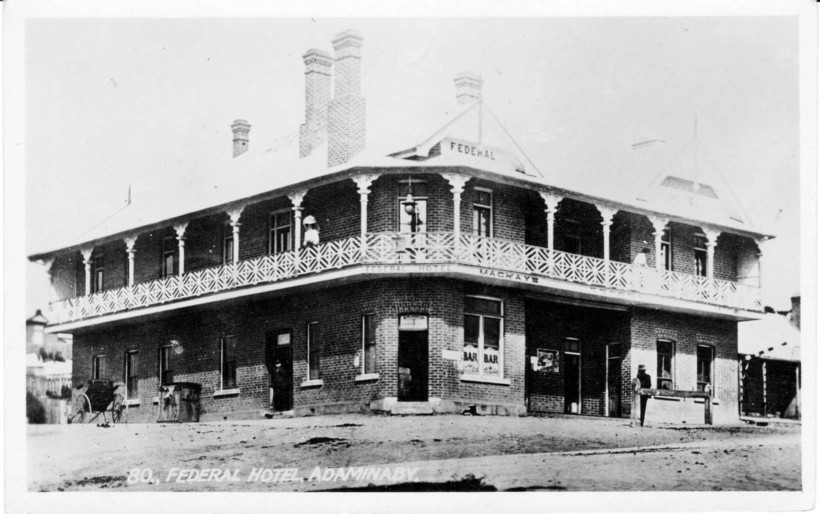 |
The following images were supplied by Judy Parrish [rjparish@bigpond.com]
I would like to acknowledge, Mrs Catherine (nee McPhie) Dunkley, daughter of Neil McKeachnie McPhie, without whom I would not have these in my possession to pass on.
Regards,
Judy Parrish
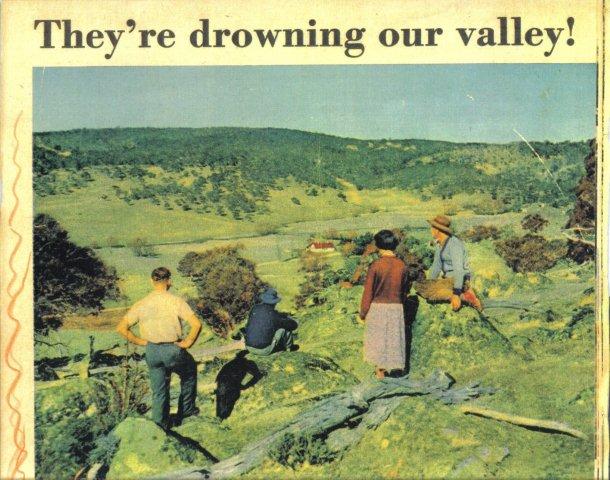 |
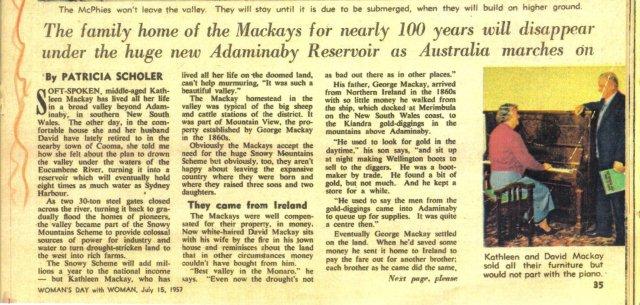 |
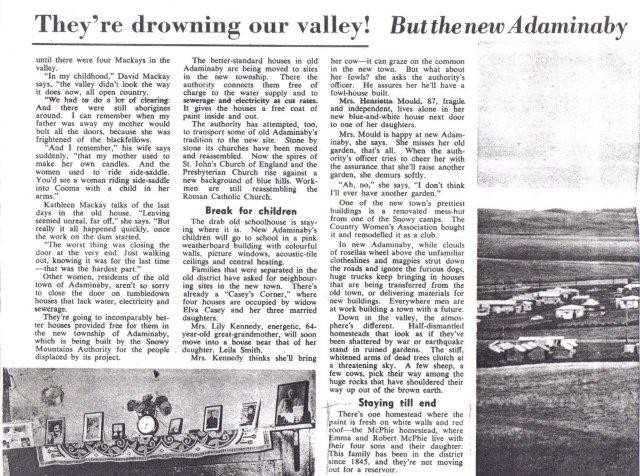 |
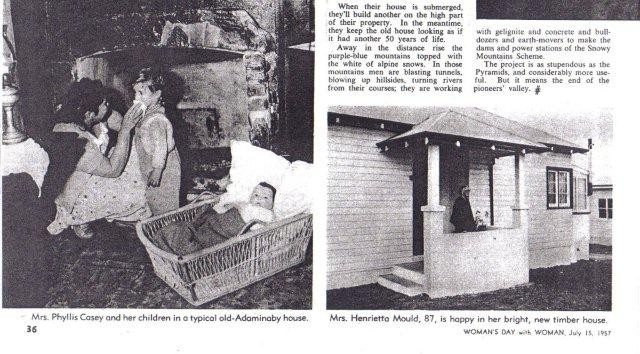 |
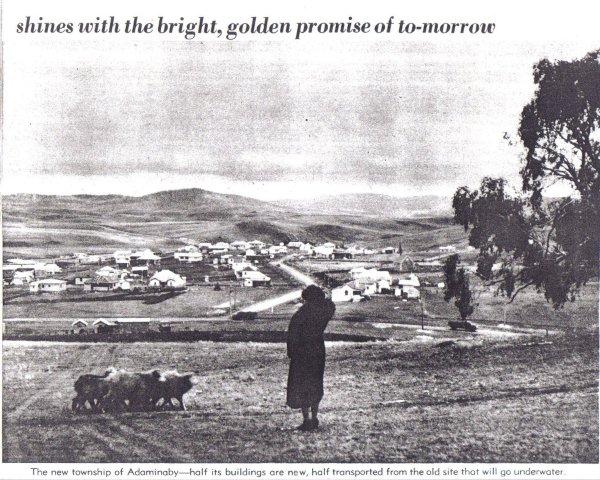 |
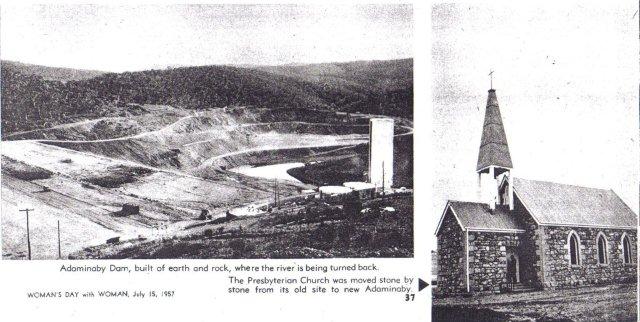 |
The following images were supplied by Janelle Jefferson
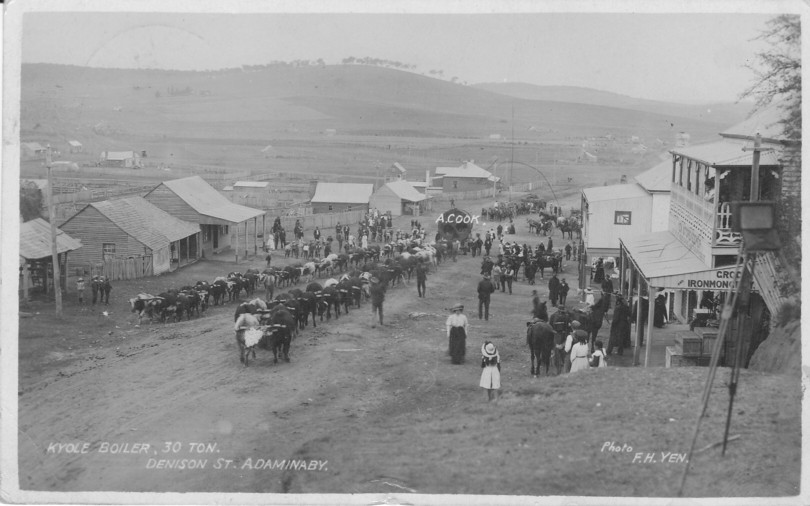 |
| Old Adaminaby c1910 |
Old Adaminaby just before the town moved.
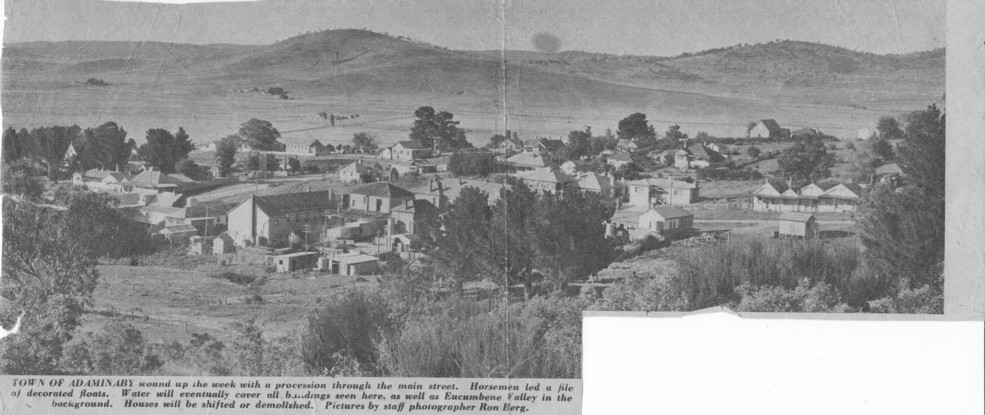 |
 |
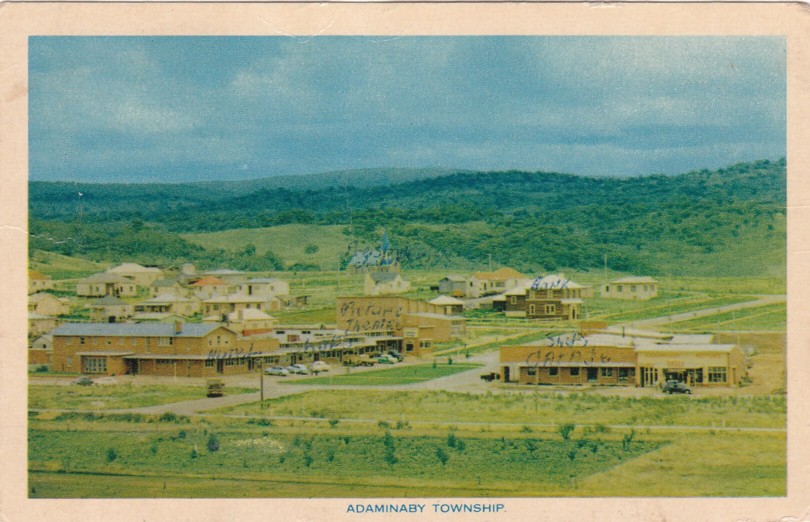 |
| New Adaminaby in its infancy |
|